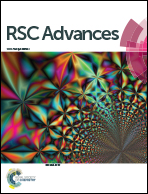High-affinity host–guest complex of cucurbit[7]uril with a bis(thiazolium) salt†
Abstract
A biologically- and pharmaceutically-relevant bis(thiazolium) dication model compound, α,α′-bis(thiazolium)-p-xylene (BTX2+), forms a strong 1 : 1 host–guest inclusion complex with cucurbit[7]uril (CB[7]). The complexation stoichiometry, binding affinity and geometry were studied via 1H NMR and UV-visible titrations, ESI-MS, and molecular modeling (ab initio calculations). The hydrogen/deuterium exchange reactions of the C(2)-proton of BTX2+ were conducted in the absence and presence of CB[7] in D2O at 25 °C and at an ionic strength of 0.20 M. The inhibition of C(2)-H/D exchange of the guest bis(thiazolium) dication upon complexation with CB[7] exhibited a second-order rate constant that decreased by more than four-fold in the presence of CB[7]. The supramolecular-controlled stability of thiazolium cations through complexation with CB[7] host molecules is anticipated to have applications for stability enhancement of thiazolium based drugs and to potentially draw interest in the application of CB[n] host molecules with regard to the formulation and delivery of these drugs.
![Graphical abstract: High-affinity host–guest complex of cucurbit[7]uril with a bis(thiazolium) salt](/en/Image/Get?imageInfo.ImageType=GA&imageInfo.ImageIdentifier.ManuscriptID=C5RA04468E&imageInfo.ImageIdentifier.Year=2015)

 Please wait while we load your content...
Please wait while we load your content...